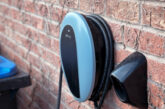
Julian Grant of Chauvin Arnoux provides more detail about harmonics and the problems they create, as well as their relationship with the Wiring Regs.
Harmonics are currents in the supply system at whole-number multiples of the supply frequency. Individual harmonics such as the 2nd occur at 100 Hz (assuming a 50 Hz supply), the 3rd at 150 Hz, the 4th at 200 Hz and so on.
In practice, the 3rd harmonic, and other harmonics that occur at odd multiples of the 3rd (for example, the 9th, 15th, 21st and so on) are among the most troublesome. These are often called “triplen” or zero sequence harmonics.
The problem is that in a four-wire, three-phase installation (which most three-phase installations are), triplen harmonic currents add, rather than cancel, in the neutral conductor. Unfortunately, neutral conductors in three-phase cables and equipment are often smaller than the other phase conductors because, in a reasonably well-balanced system with low harmonics, they carry very little current.
If triplen harmonics are present, however, there will be significant current in the neutral and, unless this is properly taken into account, it can lead to excessive heating. Something to definitely look out for!
While it’s sometimes useful to look at individual harmonics, particularly when working out what may be producing them, at other times it’s more helpful to have a measure of the combined level of harmonics in the supply. This measure is called total harmonic distortion or THD.
As electrical professionals, we’re mostly interested in harmonic currents, so we’ll want to look at total harmonic current distortion or THDi. There’s no need to calculate THDi, as any decent instrument capable of measuring harmonics will do that automatically. One of the many reasons that THDi is an important measure is that harmonics also affect power factor.
Often, we consider power factor as depending only on the phase difference between the voltage and current in the load. That is actually what is known as Displacement Power Factor. The true power factor also involves calculating the Distortion Power Factor, and for that you first need to measure THDi.
As an example, if the power factor based on the phase relationship alone is 0.90 but the THDi is 35%, the true power factor would actually be 0.85. That may sound like a small difference, but over time it can add up to a lot of money wasted on unnecessarily high energy bills. If you’re still not totally convinced about the importance of harmonics, consider this: the current edition of the IET Wiring Regs mentions the word “harmonic” no fewer than 81 times.
Regulation 132.2, for example, covers the number and type of circuits required and states that this shall be determined taking into account factors that include “any special conditions, such as harmonics”. So even at the most basic stage of deciding on how many circuits are needed in an installation, harmonics must be considered.
Regulation 523.6.201 states that “The tabulated current-carrying capacities in Appendix 4 are based on fundamental frequency only and do not take into account the effect of harmonics.” That’s important, because the tables in Appendix 4 are those normally used as the basis for designing and testing installations, and the regulation just quoted means that these tables are not necessarily valid when harmonics are present!
To show just how big an issue this can be, it’s worth restating the example we’ve used in previous articles. Using a “standard” clampmeter from a well-known manufacturer we measured the current in a circuit supplying compact fluorescent (CFL) luminaires. The reading was 2.9 A. When we repeated the measurement with a clampmeter that handles harmonics correctly, we found the true current to be 6.0 A. That’s a very big difference!
Risking overloaded circuits
Since the tables in the Regs don’t take harmonics into account, it’s down to you to do so, otherwise you risk having severely overloaded circuits. And you can only take harmonics into account if your equipment measures them correctly.
Hopefully we’ve convinced you that you definitely need to check that this is the case for your existing instruments and for any new kit you may be thinking of buying. If you’re looking for suggestions about which new instruments to buy, we recommend that you consider the F407 and F607 clampmeters from Chauvin Arnoux, which measure currents up to and including the 25th harmonic (1250 Hz), and also feature true RMS measurement.
As an electrician, complying with the Wiring Regulations is something that you almost certainly aim to do every day of your working life. But you can only be sure of succeeding if you’ve got the right kit. In today’s world, that includes instruments which give dependable readings, even when harmonics are present.
Get more technical information on harmonics and other power quality issues by clicking here











